Lyon managed to put themselves one point above Paris Saint-Germain on the Ligue 1 table 14 games into the 2020/21 campaign this past weekend as they managed to secure a 1-0 win over PSG in Sunday’s late kick-off in France’s top flight.
This game served Les Parisiens their fourth loss of the 2020/21 league season, which is more defeats than they endured in the entirety of last season or the 2017/18 season, while the two teams sitting above them on the league table have both lost just once at this stage of the campaign.
In this tactical analysis piece, we’re going to look at the tactics behind Lyon’s win over PSG. We’ll take an in-depth look at how both of these sides set up in all phases of play, and we’ll provide analysis of what the determining factors behind the outcome of the fixture were.
Lineups and formations
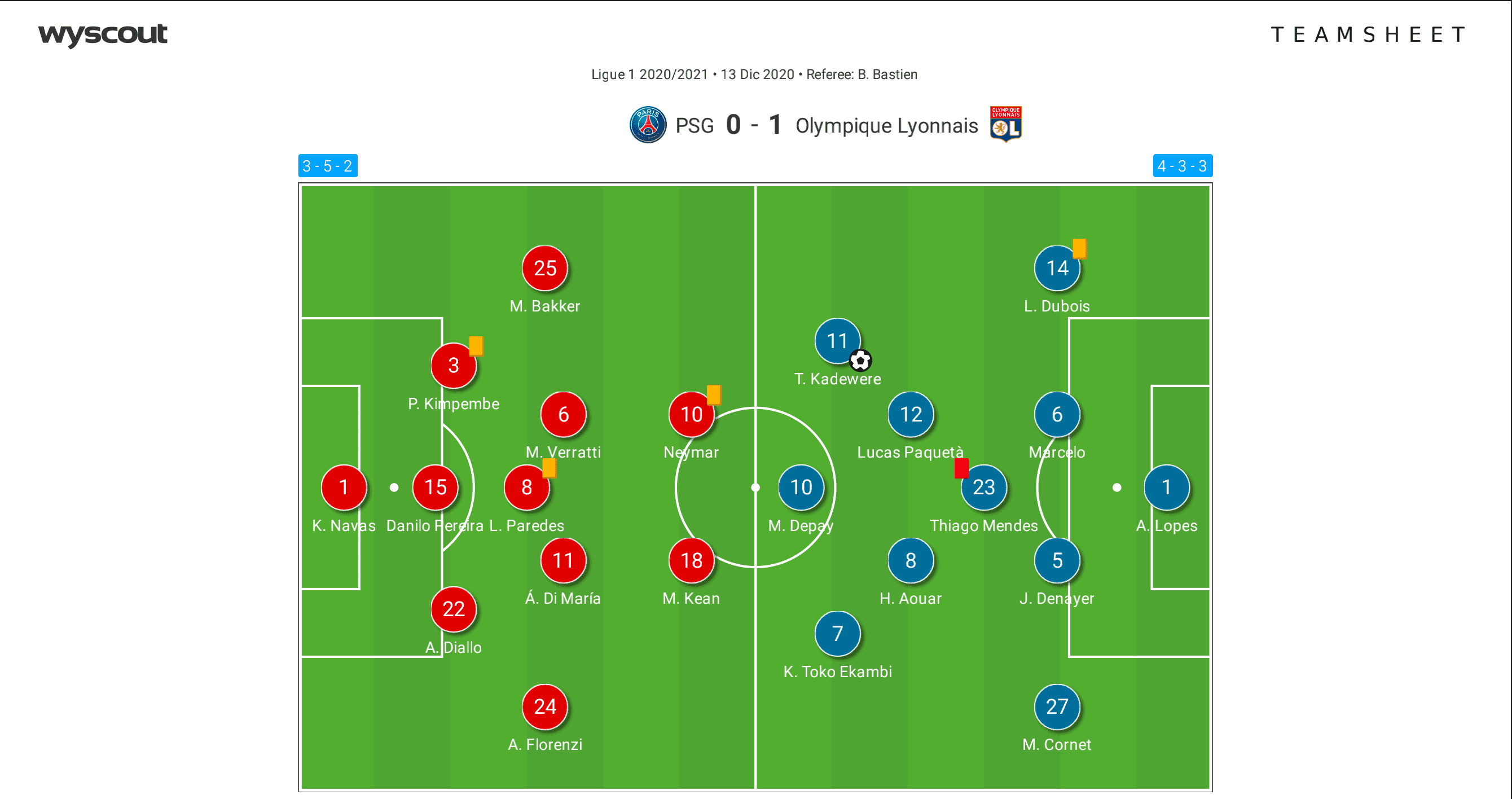
Firstly, we’re going to run through both teams’ lineups and formations from Sunday’s game, before getting into the tactical analysis portion of this piece.
Starting with Thomas Tuchel’s side, PSG lined up in a 3-5-2 shape for Sunday’s game. This was a strange choice of shape for them, as they usually play with a back four, lining up in either a 4-3-3 or a 4-4-2 shape.
Keylor Navas started in goal for Les Parisiens, just behind left centre-back Presnel Kimpembe, right centre-back Abdou Diallo and central centre-back Danilo Pereira, who is on loan at PSG from FC Porto. Mitchel Bakker started at left wing-back, Alessandro Florenzi, on loan at PSG from AS Roma, started at right-back and the home side’s central midfield trio consisted of Marco Verratti on the left, Ángel Di María on the right and Leandro Paredes in the centre, though, due to the way PSG set up both on and off the ball, Di María often ended up in a more advanced position than the other PSG midfielders, just behind the striking duo of Neymar and Moise Kean – the latter of whom is on loan at PSG from Everton.
We’ll discuss that at greater length later on in this tactical analysis piece.
PSG also made five substitutions in this game. Firstly, Thilo Kehrer replaced Diallo in the 29th minute, with the defender forced off due to a hamstring injury. Then, in the 64th minute, PSG made a triple substitution, as Idrissa Gueye replaced Verratti, Ander Herrera replaced Paredes and Kylian Mbappe replaced Di María, adding extra firepower to the forward line. Lastly, in the 72nd minute, Kean left the pitch, as Rafinha was introduced to the game.
As for the away side, Rudi Garcia lined his men up in a 4-3-3 shape for this one. Anthony Lopes started in goal for Lyon, their back four consisted of right-back Léo Dubois, left-back Maxwel Cornet, left centre-back Jason Denayer and right centre-back Marcelo.
Thiago Mendes played the holding midfield role just in front of them and just behind the more advanced central midfield duo of Houssem Aouar on the left and Lucas Paquetá on the right, while Memphis Depay started in the centre-forward position for Lyon in this game, with Tino Kadewere on his right and Karl Toko Ekambi on his left, completing Les Gones’ starting XI and front three.
Lyon also made all five of their substitutions in this game, the first of which came in the 65th minute as Mattia De Sciglio replaced Dubois at right-back. Later on, in the 77th minute, Garcia added some steel to his defence as Sinaly Diomandé replaced Kadewere. That substitution was quickly followed by two other changes, with Moussa Dembélé replacing Depay and Bruno Guimarães replacing Aouar. Lastly, in the 88th minute, Lyon introduced Maxence Caqueret to see out the game in central midfield, as Paquetá left the pitch.
PSG’s tactics off the ball
As we move on into the next part of this tactical analysis piece, we’re first going to provide some analysis of the home side’s tactics off the ball. In this section of the analysis, we’re going to examine PSG’s press, how they defended well in deeper areas despite giving up some space out wide by leaving two attackers quite far up the pitch, and we’ll look at one negative aspect of their defensive play from the second half of this game.
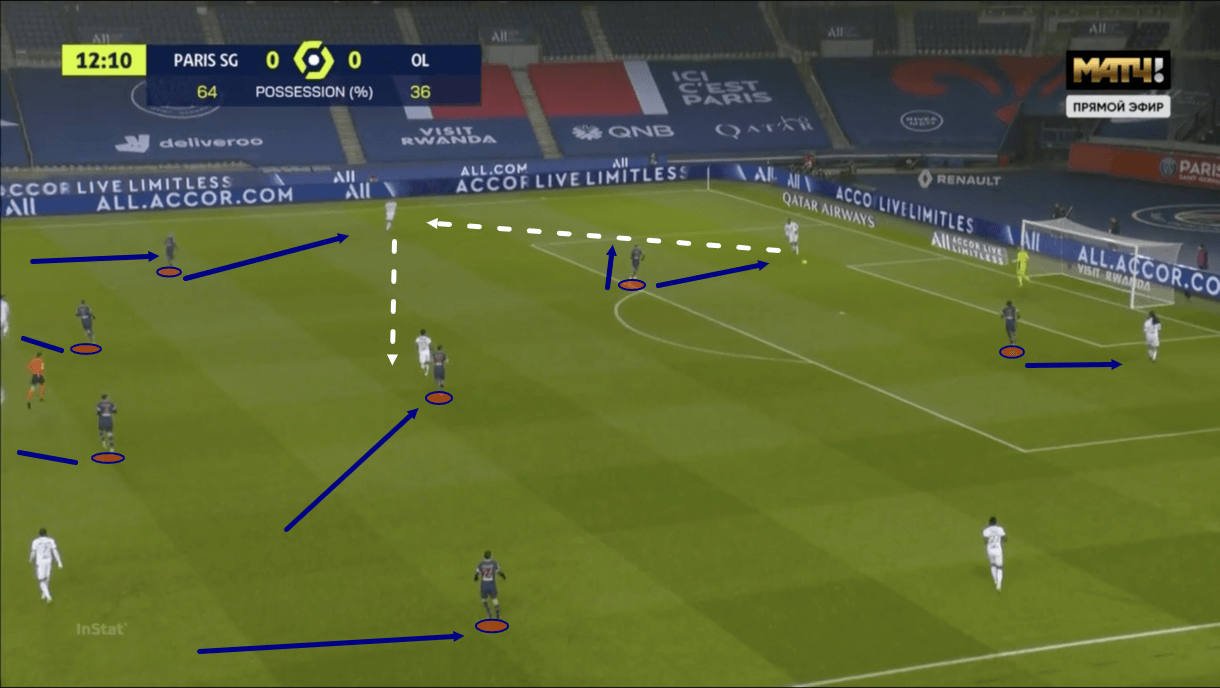
This first image shows us how PSG pressed Lyon in Sunday’s game. Tuchel’s side defended quite aggressively, with their front line pressing up the pitch, giving Lyon’s centre-backs no time or space to take their time while playing out from the back. Here, we can see Marcelo receiving the ball after it’s been played across goal to him by Denayer. As he prepares to receive the ball, he’s immediately being pressed by Neymar, while Kean moves up to cut off the passing lane back to Denayer, while also maintaining access to the goalkeeper, should he opt to play it back to him.
One benefit for PSG, in terms of their shape, was that their two centre-forwards could match up 1v1 against Lyon’s two centre-backs. Their lack of numerical superiority in this area of the pitch made it difficult for Lyon when trying to play out from the back.
As PSG’s forwards advanced on Lyon’s centre-backs, the midfield and wing-backs followed suit. Di maría was usually tasked with, essentially, man-marking Mendes in the centre of the pitch, preventing Lyon from playing out through him. At the same time, PSG’s other two central midfielders stayed slightly deeper and tight to Lyon’s more advanced midfield duo.
Meanwhile, PSG’s wing-backs then pushed up and maintained access to Lyon’s full-backs. As Florenzi demonstrates in this image, PSG’s wing-backs didn’t get too tight to Lyon’s full-backs when the ball was on the other side of the pitch, but when the ball was played out to the full-back, that’s when they pressed more aggressively and aimed to force a pass into the centre. This would see Marcelo pass the ball to Dubois and then into Mendes here.
As we can see, Mendes would then be surrounded by PSG players who would close in on him and attempt to force a turnover high up the pitch.
Due to the man-oriented nature of their defensive set-up, particularly in midfield, PSG’s defensive shape appeared to be more of a 3-4-1-2 at times, as this image shows.
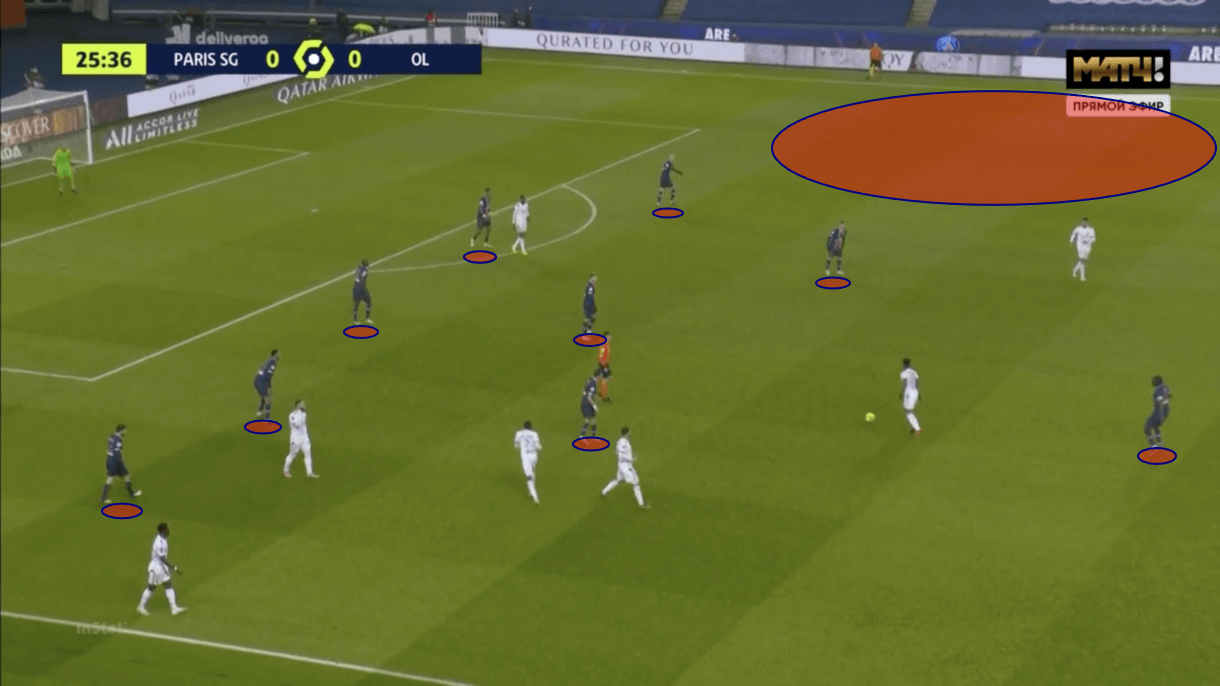
While defending deep, PSG gave up quite a lot of space out wide, as the image above shows. This was a result of Tuchel opting to leave both Kean and Neymar in the front line when the ball had been played past the first line, and as they played with three central midfielders, this left them seemingly lacking for cover out wide once Lyon played into this area.
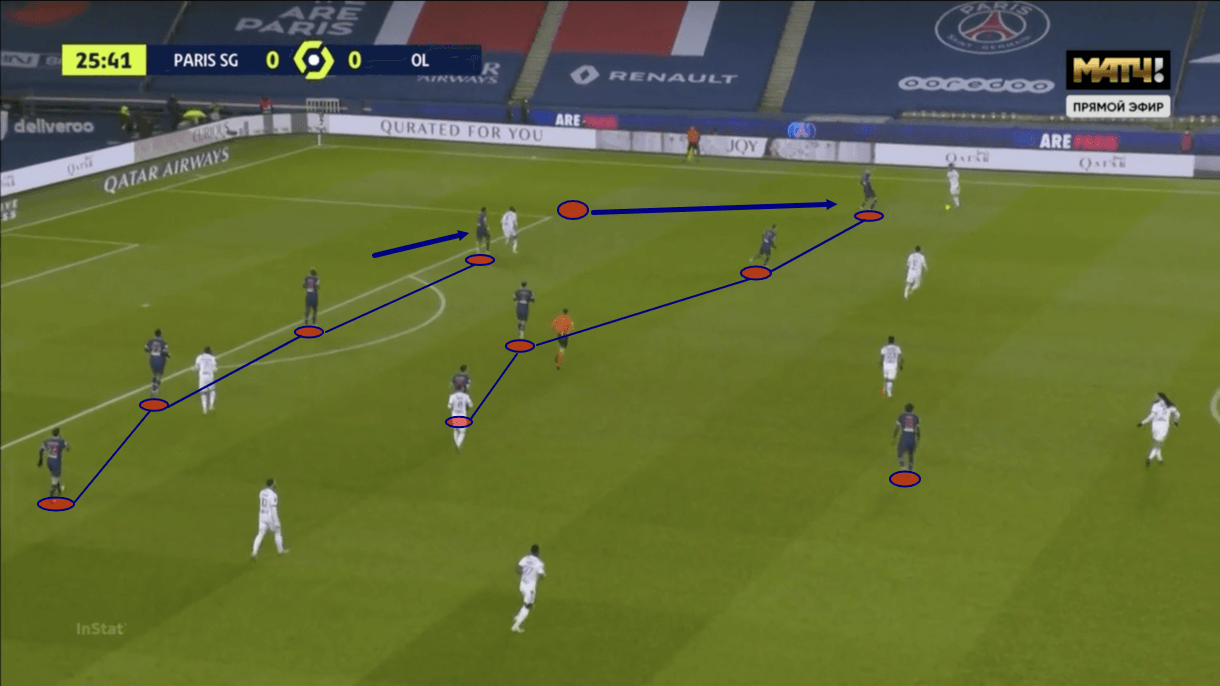
This was something Les Gones attempted to exploit on a couple of occasions, but when they tried to do so, it then became clear how PSG were well-drilled to deal with this situation.
As the ball was played from the centre out into the wide area, the wing-back would push out from the backline and close down the Lyon man, essentially becoming a left midfielder and forming a four-man midfield line. At the same time, the near-sided centre-back would shift out into the full-back position. As the rest of the backline followed them, a back four was formed, essentially allowing PSG to transition into a 4-4-1-1 shape, which provided plenty of cover out wide, in this scenario.
The transition into this shape did create a large gap between the centre-back becoming a full-back and the central centre-back on occasions, but it wasn’t really exploited by Lyon, so it wasn’t a major issue for them.
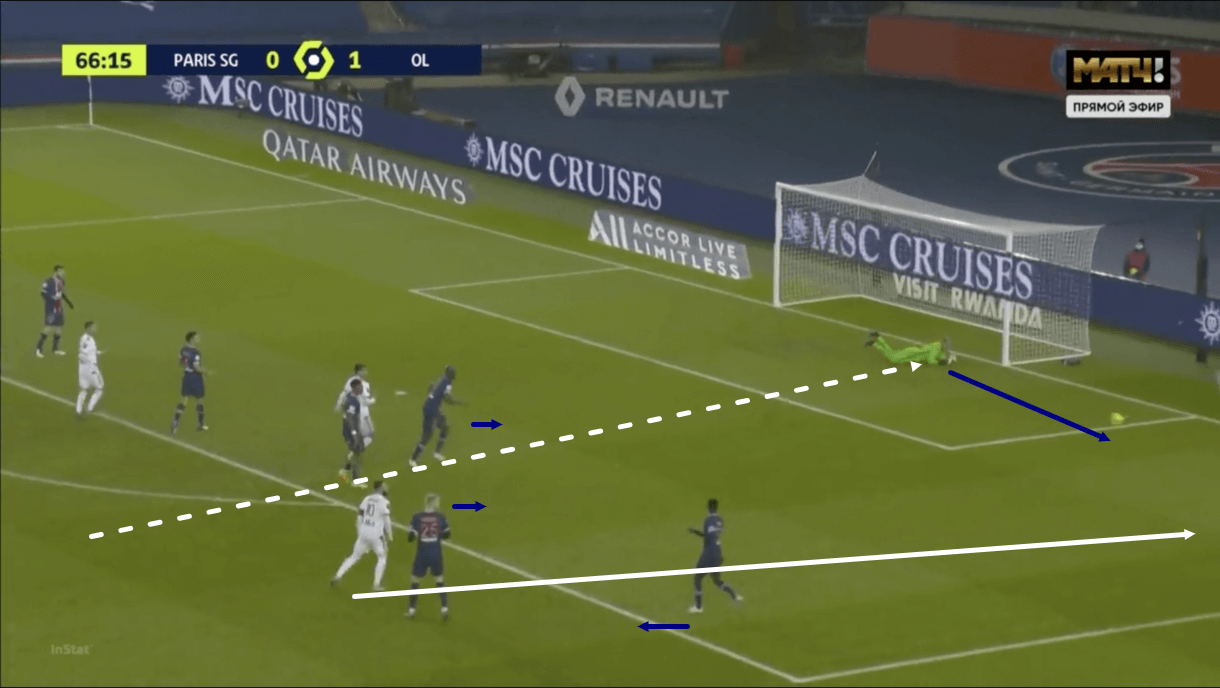
Lastly, it was notable that in the second half of this game, it seemed as though PSG’s intensity, urgency, reaction speed and concentration slipped somewhat, allowing Lyon to become more and more comfortable with their lead.
The image above shows us one example of this. Just prior to this image being taken, Lyon hit a long-shot which Navas manages to parry out wide and as the ball begins to move out from the box, PSG’s defenders are very slow to react, and despite more PSG bodies being around this area and closer to the ball than Depay, the Dutchman ends up getting the ball back for his side. At the same time, PSG’s defenders were just too slow to react. This lack of concentration and intensity in the second half was evident in their pressing at times, their reactions to situations like this or when tasked with getting back to support each other in stopping a Lyon counter-attack, and their dribbling, with PSG players carrying the ball straight into Lyon players from deep, allowing turnovers in dangerous areas at times in the second half.
Lyon’s tactics off the ball
Next up, we’ll provide some analysis of Lyon’s tactics off the ball in Sunday’s game. This section of the analysis will take a look at how Lyon pressed PSG and how they defended in deeper areas of the pitch at different times in this one.
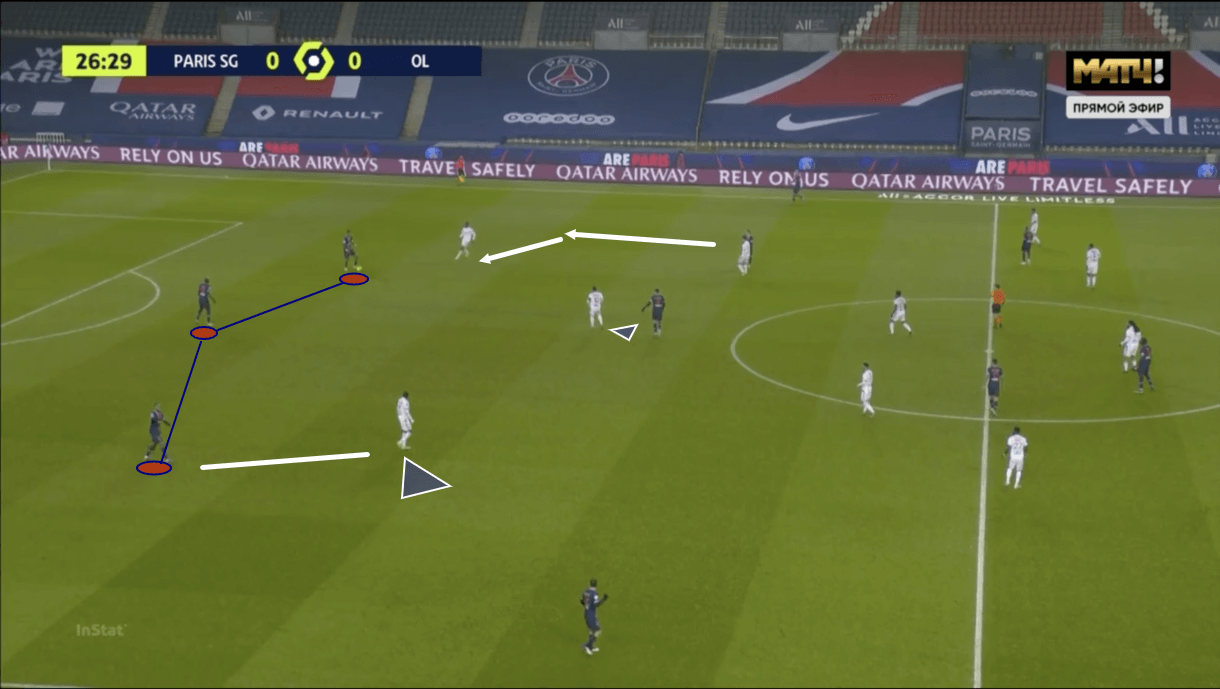
Firstly, this sequence of play will give us a good demonstration of Lyon’s pressing from this win over PSG. This was one of Lyon’s most useful assets from their latest Ligue 1 fixture, with Kadewere’s 35th-minute goal coming as a result of Lyon forcing a turnover high up the pitch.
In the image above, we can see Lyon lined up in their 4-3-3 shape, deploying a fairly high line at this moment in time, as PSG attempt to build out from the back. As PSG’s wide centre-backs got on the ball, they were pressed by Lyon’s wingers, but Kadewere and Toko Ekambi didn’t just press the wide PSG centre-backs straight on; instead, they angled their press to come from the outside, inwards, allowing them to cover the passing lane out to the wing-back.
Instead of pressing high on Pereira, Depay usually sat a bit deeper, keeping central midfielder Paredes in his cover shadow. Meanwhile, we can see that PSG’s left central midfielder, Verratti, was followed as he dropped deep to make himself a passing option.
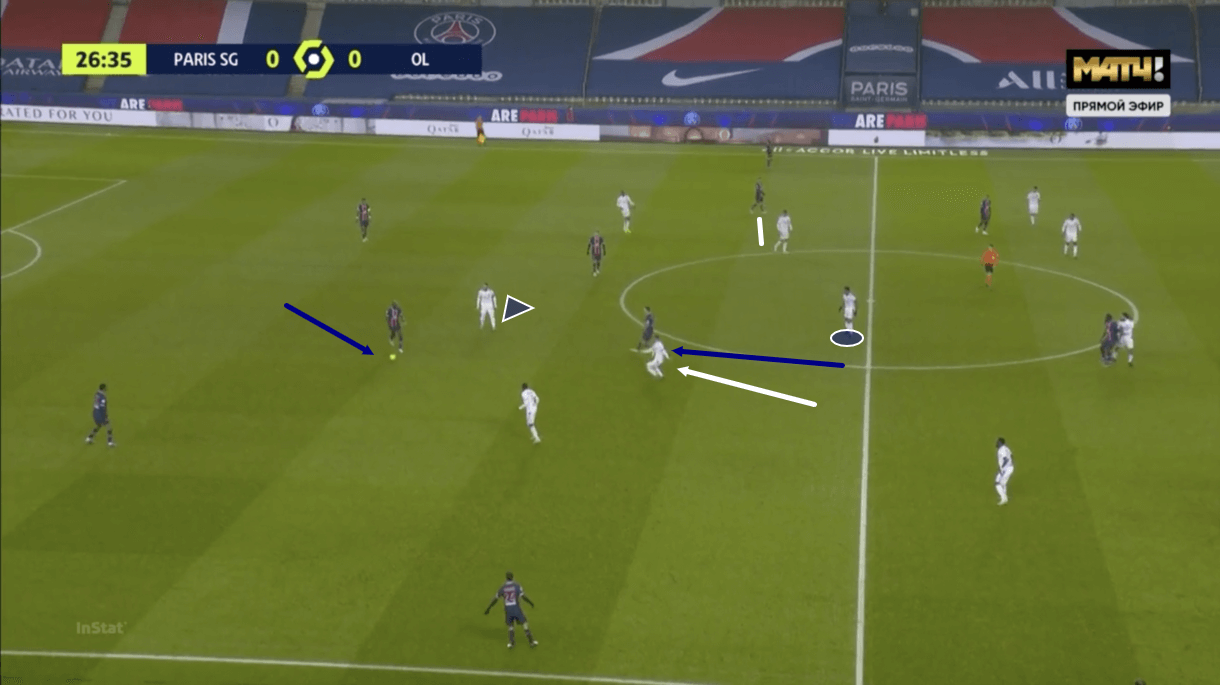
As Depay held a deeper position, that gave Pereira some space and time, and he often used that to attempt to carry the ball out from the back. While he was sometimes successful in doing so – and became one of PSG’s most useful assets during the build-up in this fixture as a result – he wasn’t always successful at this, with Lyon’s press preventing him from progressing the ball forward at times and this sequence of play provides us with an example of one such occasion.
Here, as Pereira brings the ball forward, Depay closes in on him while keeping the passing lane to Paredes in his cover shadow, while Di María drops deep to provide support but similar to Verratti on the other side of central midfield, he’s followed by a Lyon player. Meanwhile, Toko Ekambi pushes up and covers the passing lane out to Florenzi, as this sequence of play moves on.
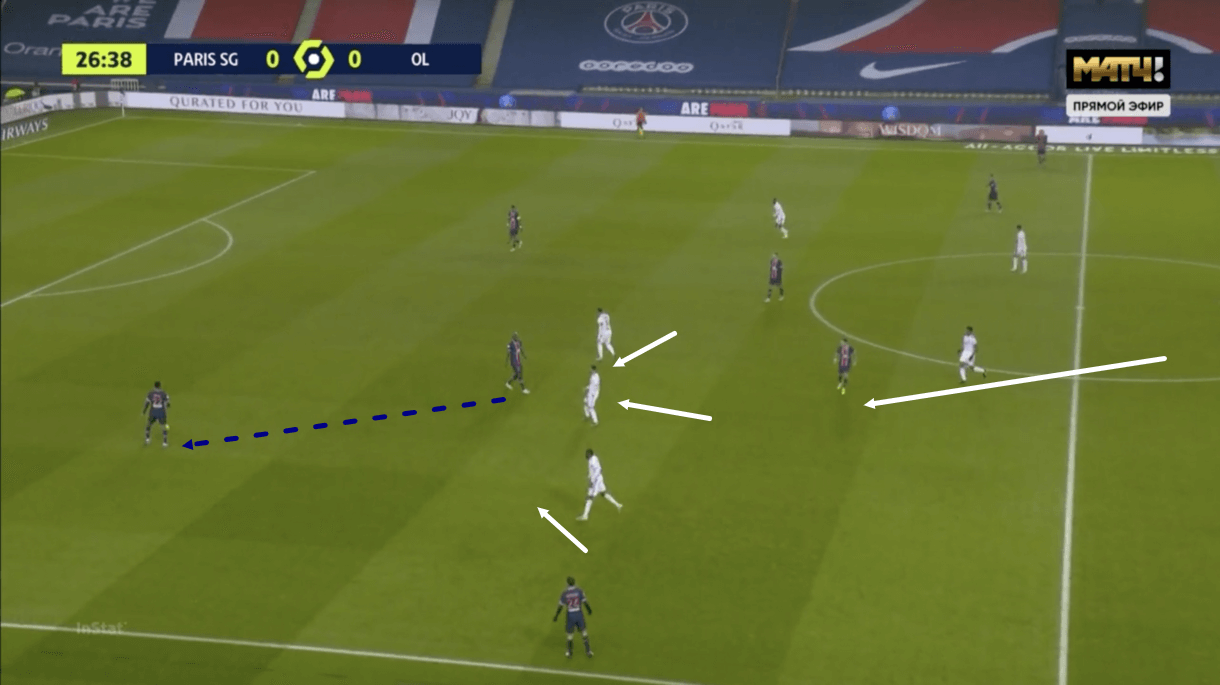
This ultimately forces Pereira to play the ball back to the right centre-back. As he does so, Aouar, who had been marking Di María, now pushes up onto Pereira. With Lyon’s press intensifying even more and Les Gones committing more bodies forward, Mendes then pushes up to cover Di María, who would otherwise have been left free in midfield.
As we saw in the other images, the benefit for Lyon of having Depay sit deep on Paredes was that they essentially created a 4v3 advantage for themselves in central midfield, with Mendes basically becoming a free man. As a result, he was free to push up onto Di María when Aouar opted to press higher.
It didn’t take too long for PSG defenders to start making errors while attempting to play past Lyon’s effective press as this game wore on and they seemingly became more and more eager to get the ball up the pitch. As they dribbled into areas crowded by Lyon bodies, Les Gones managed to counter-attack from dangerous positions, keeping the home side on the back foot for portions of this game.
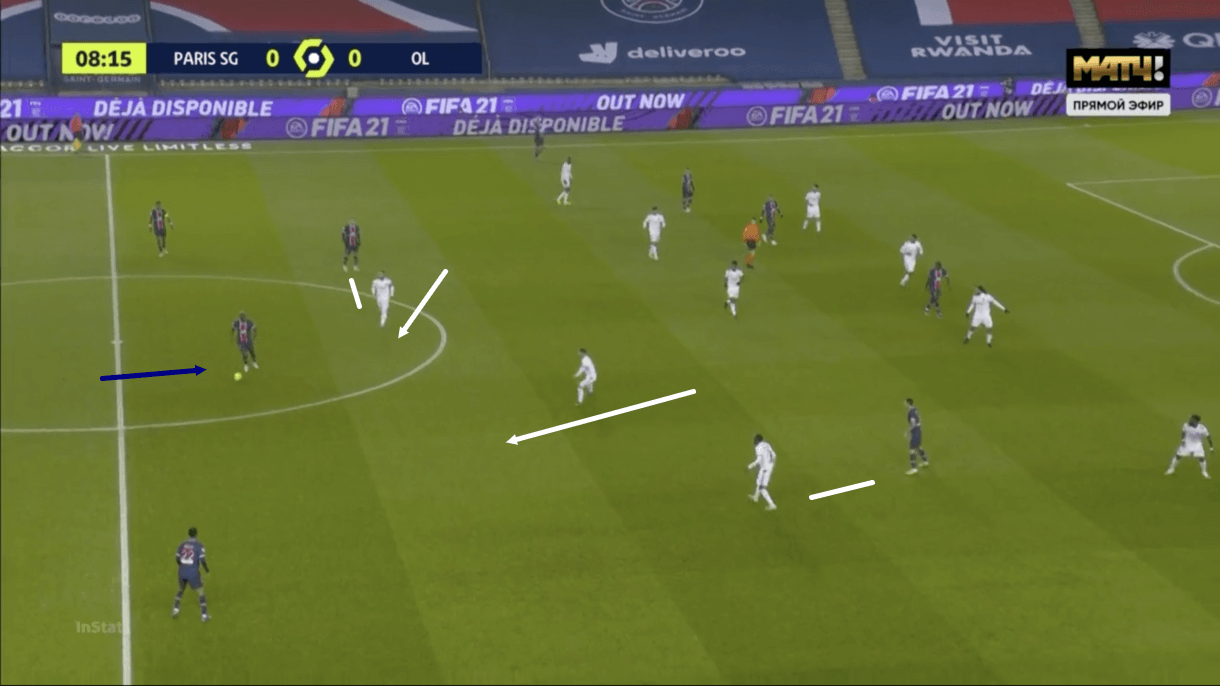
When defending in a slightly deeper area of the pitch, due to PSG getting the ball into a more advanced area, Lyon’s wingers dropped, and their shape became a 4-5-1, but during these phases of play, Lyon began to press more aggressively when PSG’s players crossed the halfway line. Up until that point, they sat off.
As well as Depay, the nearest Lyon player to the man on the ball would press high, and this resulted in Lyon’s shape resembling a 4-4-2 at times, as seen in the image above. This was just a result of Lyon’s pressing tactics, however.
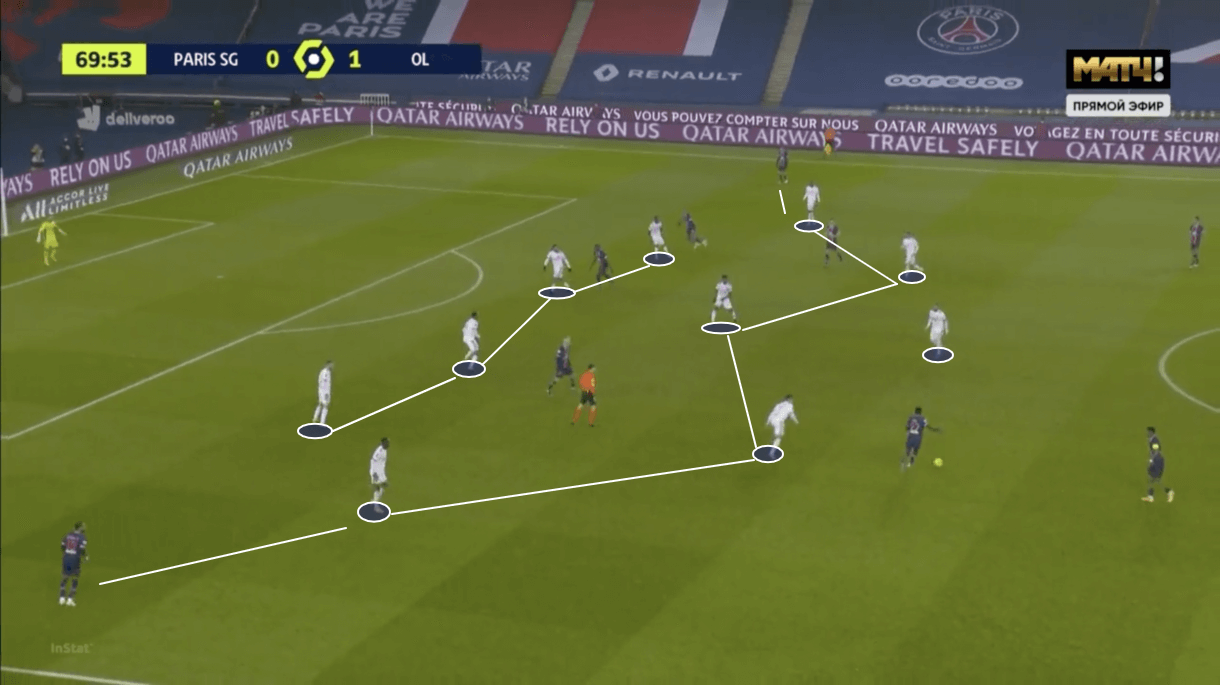
As the game wore on, with Les Gones keen to protect their lead, they began to drop into a deeper and deeper block, while their line of engagement also dropped. Furthermore, their wingers essentially became wing-backs, as the image above shows, as they dropped deeper than the midfield line to maintain access to the PSG wide men and ensure that the full-backs could hold their position more centrally.
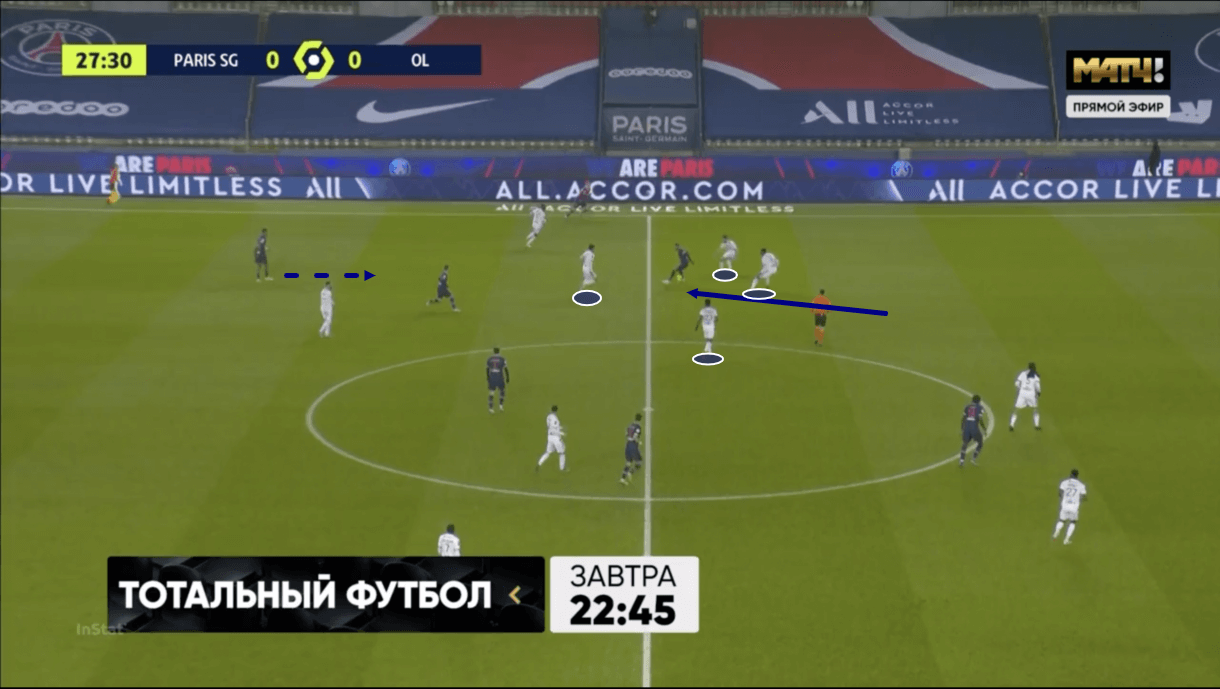
Lastly, as Neymar dropped into the half-space at times to collect the ball from the backline or midfielders, Lyon set up very well to deal with it, as the image above shows. No one player was tasked with man-marking Neymar. Instead, numerous Lyon players directed their attention towards him when he dropped deep into these areas and essentially formed a cage around him, limiting the space he enjoyed to dribble into and closing in on him to prevent him from getting too far with the ball.
This was more effective than trying to defend against Neymar 1v1 or even, perhaps, 2v1 would be, as he is such a good dribbler and so, restricting the space around him from various angles was a wise tactic.
PSG’s tactics on the ball
Now we’re going to focus on how PSG played with possession of the ball in Sunday evening’s game. In this section, we’ll provide some analysis of Les Parisiens’ general offensive shape from Sunday’s fixture and some of the key elements to their offensive tactics.
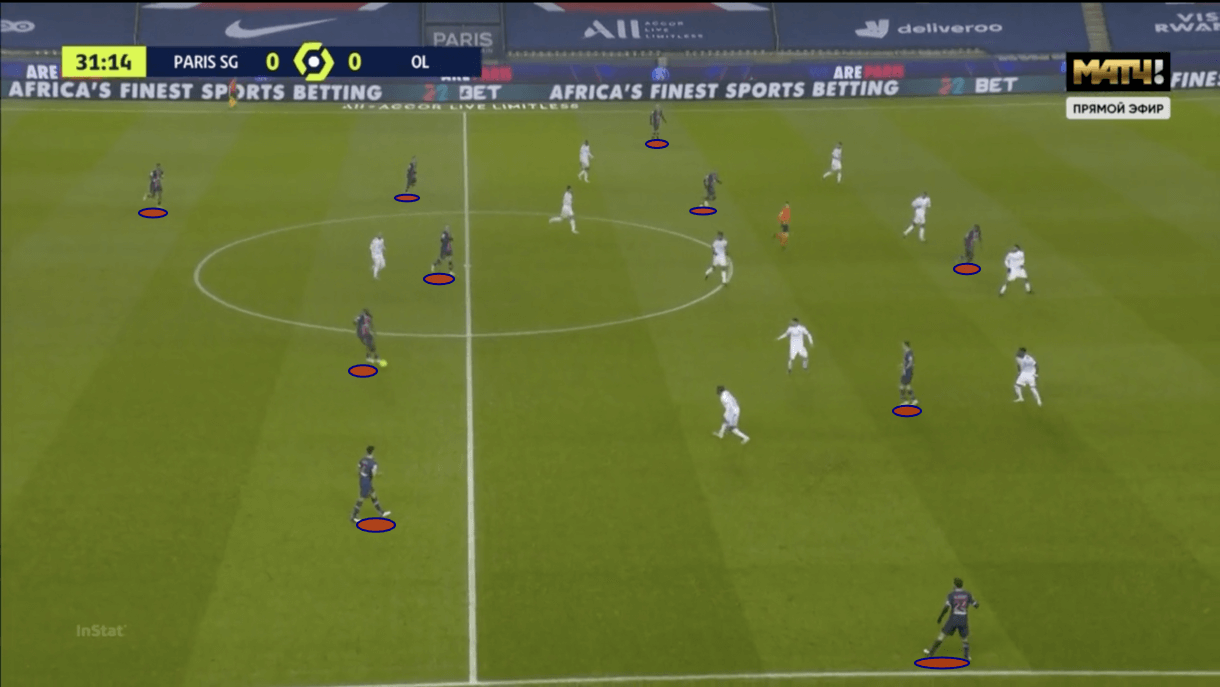
This first image provides us with an example of PSG’s general offensive shape from their most recent Ligue 1 game. We can see their back three and two of their central midfielders, Paredes and Verratti, just inside of their half here. Both of these midfielders liked to stay deep in order to avoid Lyon’s tight marking to an extent and potentially enjoy more time and space on the ball, while they also performed well when receiving the ball with a Lyon player then pressing them, as they showcased some impressive dribbling ability on these occasions.
Meanwhile, we can also see, on the other side of the pitch, they’ve formed what is essentially a front five consisting of the two wing-backs, Florenzi on the right and Bakker on the left, both positioning themselves high on either wing, providing the width for their side, Di María having pushed up from his right central midfield position into the right half-space, with Neymar having withdrawn slightly from his left centre-forward position into the left half-space, leaving Kean free to occupy a more central striking position.
We can also see one of the key aspects to PSG’s build-up play in the image above, which is Pereira carrying the ball out from the back, into, essentially, the midfield line, to try and advance the play.
When building into the opposition half in a position like this, PSG’s centre-backs had a few different options, they could either play the ball into the feet of one of the players in the half-space and hope that one of the two elite dribblers would be able to make use of that space to create something or link up with a teammate and this is an option they tried to make use of on a few occasions but not with much success.
Meanwhile, as we can see, due to the horizontally compact nature of Lyon’s defensive block when defending in a slightly deeper area of the pitch like this, they gave up plenty of space out wide, which is an area PSG’s wing-backs could exploit and PSG’s deeper players often sent the ball down the wings to these wing-backs in the hope they would create something via their wing play. This was largely ineffective, with crosses not meeting the grade on occasion and at other times, PSG’s lack of a significant aerial presence inside of the box making it difficult for the home side to capitalise on the balls into the box.
As a result, they failed to make Lyon pay for giving up this space out wide, while Lyon’s decision to protect the centre of the pitch and the half-spaces first and foremost, thus giving up this space to the wing-backs, ended up proving an intelligent one.
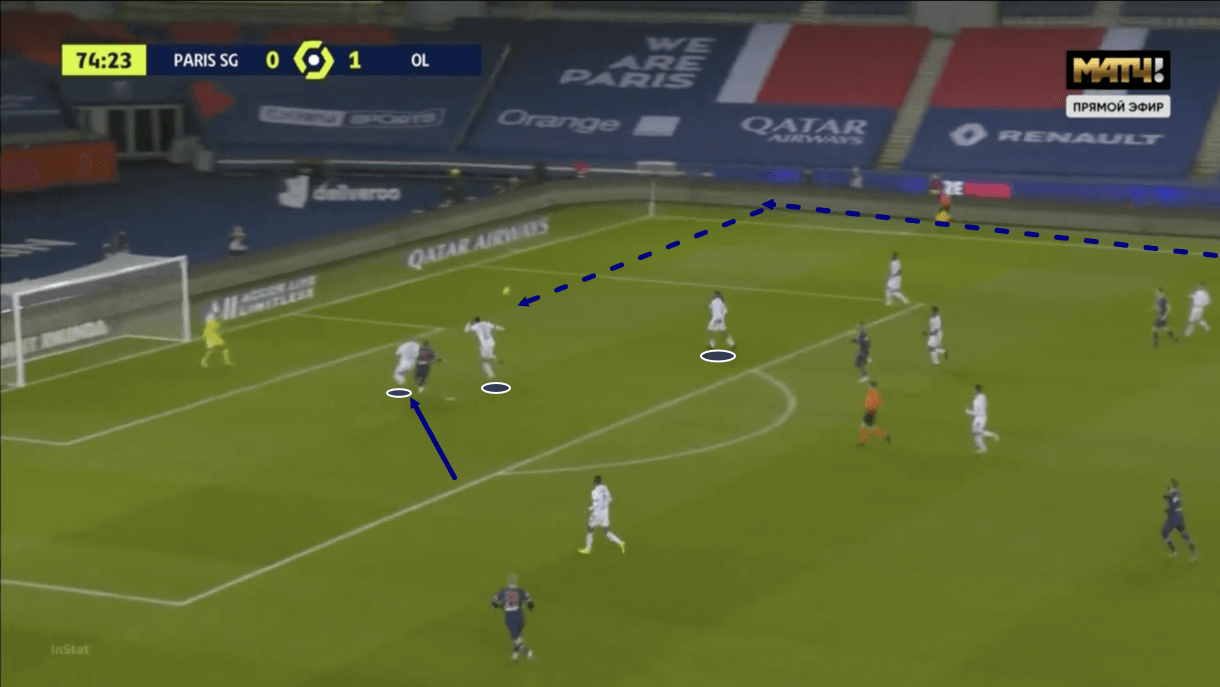
The image above provides us with a second-half example of a Florenzi cross which failed to really trouble PSG and highlights the lack of presence the home team had in the penalty area. Florenzi crossed early upon receiving the ball out wide – perhaps as a result of some uncertainty he’d be able to beat Lyon’s full-back by carrying the ball upfield, but the early floated cross did not create an optimal goalscoring opportunity for his side, with only Neymar in the penalty area and two much larger Lyon defenders right there with him.
It wasn’t unusual to see PSG attempting crosses in scenarios similar to this in Sunday’s game where the odds were heavily stacked against them concerning the likelihood they’d score from the cross, and this shows why Lyon were happy to give the wing-backs the space that they gave them.
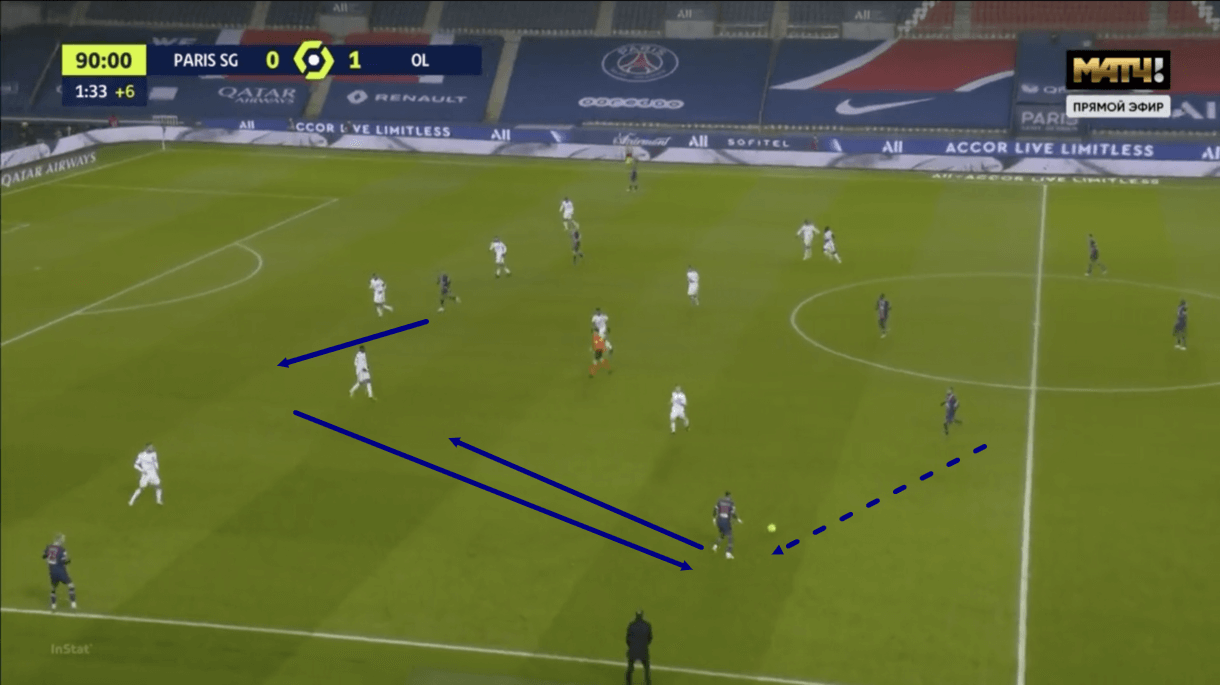
We’ve established that Neymar liked to drop off from his central attacking position into slightly deeper areas of the pitch throughout Sunday’s game. As the match wore on, the Brazilian began to come even deeper, collecting the ball in positions like this one, we can see him occupying in the image above.
As he did so, he created space for other attackers, such as Mbappe, to make runs into and potentially exploit. When moving into positions like this, particularly late on in the game, Neymar utilised his elite dribbling quality to carry the ball upfield, in an attempt to attract Lyon players out of position, towards him, all the while creating space for his teammates. This was an effective tactic in terms of ball progression, but Les Parisiens ultimately failed to create a real clear-cut goalscoring opportunity by doing this, as Lyon generally had many numbers back to cover for others if they did get dragged out of position or to crowd around Neymar and limit how much trouble he could cause on the ball.
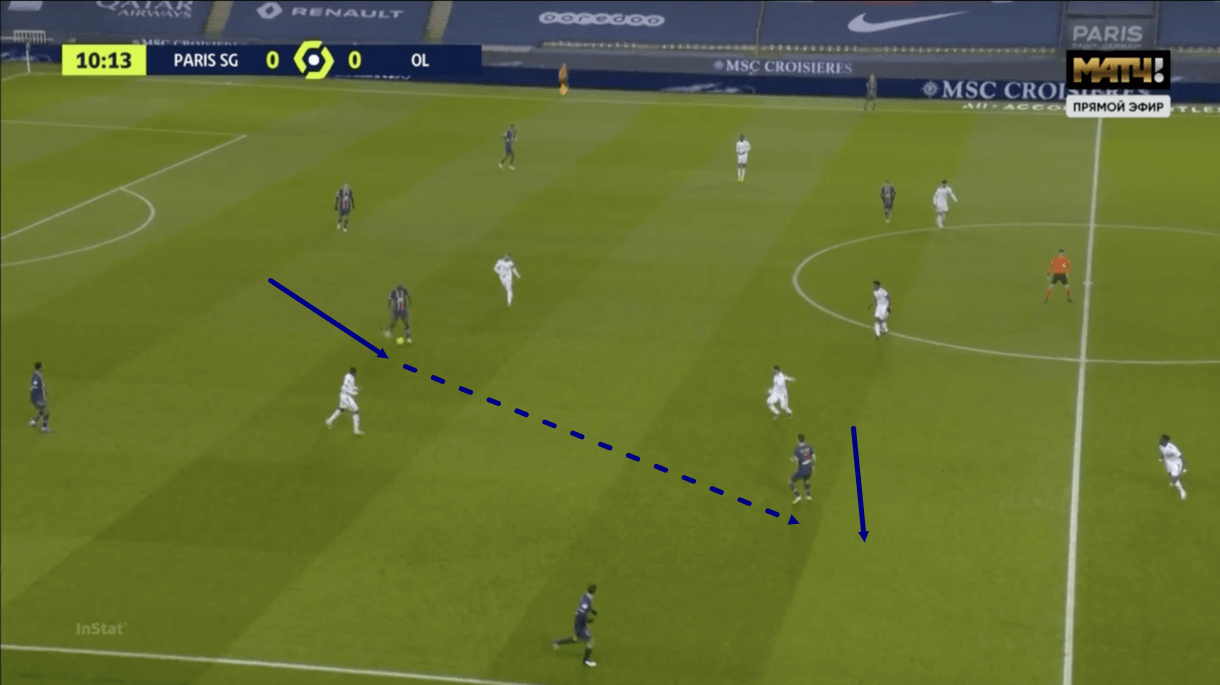
Di María also demonstrated some interesting movement in this one which helped his side in terms of ball progression. Though he played as a central midfielder and pushed up into the half-space, forming part of PSG’s front five in the mid-advanced stage of the attack, Di María’s movement played a pivotal role for Tuchel’s side during the build-up as he liked to subtly drift from centre of the pitch out into this channel we can see him occupying in the image above, in between the central midfield area and the wing, which Florenzi occupied.
From here, Di María would either attempt to carry the ball upfield or, if not given enough space to do that, try and play a line-splitting progressive ball from this area up to the more advanced attackers.
Di María’s movement caught Lyon off guard multiple times and proved to be a valuable tool for PSG in the build-up.
These offensive tactics were useful in helping PSG to progress from their half of the pitch on occasions and helped to ensure that they didn’t end up pinned back in their half for the game, as Lyon’s pressing really did stifle their play; however, these tactics were still ultimately not enough to create much for PSG and perhaps the fact that, per Understat, they ended the game with an xG of just 0.31 from their seven shots at goal backs up that point – their chance creation was poor, as our look at their crossing demonstrated.
Lyon’s tactics on the ball
Lastly, we’ll look at Lyon’s tactics on the ball from Sunday’s win. Their aggressive pressing was arguably their best playmaker in this contest, with their goal coming via such a situation, however, in this section, we’ll look at some of the key tactics they deployed on the ball, with a particular focus on how they made the most of transitions.
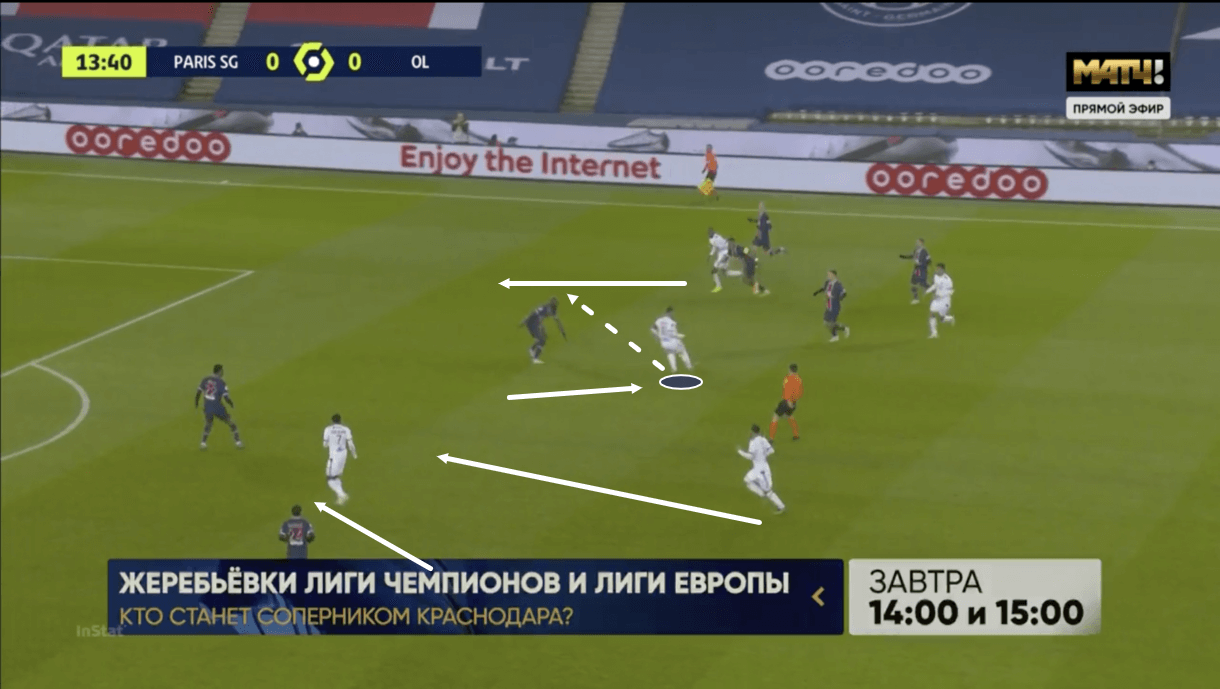
Firstly, the movement of Lyon’s front five, including the two advanced central midfielders, was a key aspect to their offensive tactics in Sunday’s win over PSG. The movement of centre-forward Depay, in particular, played a notable role in helping Les Gones to forge chances against PSG. The image above, shows us one example of the Dutchman dropping deep as his side are building into the final third to get on the ball and link up with Kadewere, who he ends up playing in behind via a through ball.
Depay’s movement into these slightly deeper areas also created space for left-winger Toko Ekambi to move into, while Depay also seemingly swapped positions with Aouar on a couple of occasions and that movement worked to great effect in creating space for Aouar centrally, as Depay attracted attention away from that area as he dropped. So, Depay’s unselfish movement evidently played an important role for his side, as it created plenty of space for his attacking teammates.
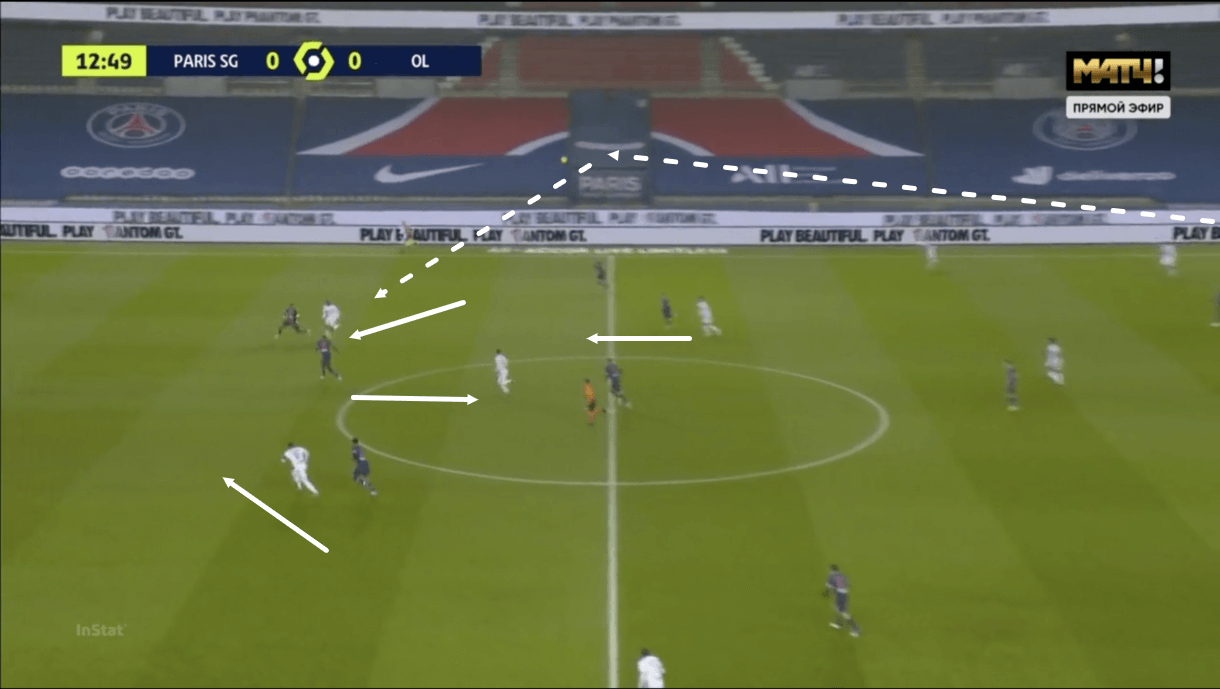
One reason why Lyon’s pressing was more effective than PSG’s pressing may be the fact that Lyon were far more comfortable with playing the ball long than PSG were. On the few occasions when PSG played the ball long, the pass was generally either intercepted by a Lyon defender or the ball resulted in an aerial duel that a Lyon man won.
However, in the form of Kadewere and Toko Ekambi, Lyon had two attackers who could contest aerial duels or use their ball control to get on the receiving end of a long-ball, hold up the play and help their side to break into the final third.
The image above shows us one example of a long-ball being played past PSG’s press and up to Kadewere who held the ball up well. Additionally, Depay, once again, dropped deep in these situations. His physical presence was not as significant as Toko Ekambi or Kadewere, but he could drop into this area and provide support for those players, along with Lyon’s advanced midfielders, once they get on the ball and his dribbling quality could then be useful in carrying the attack forward.
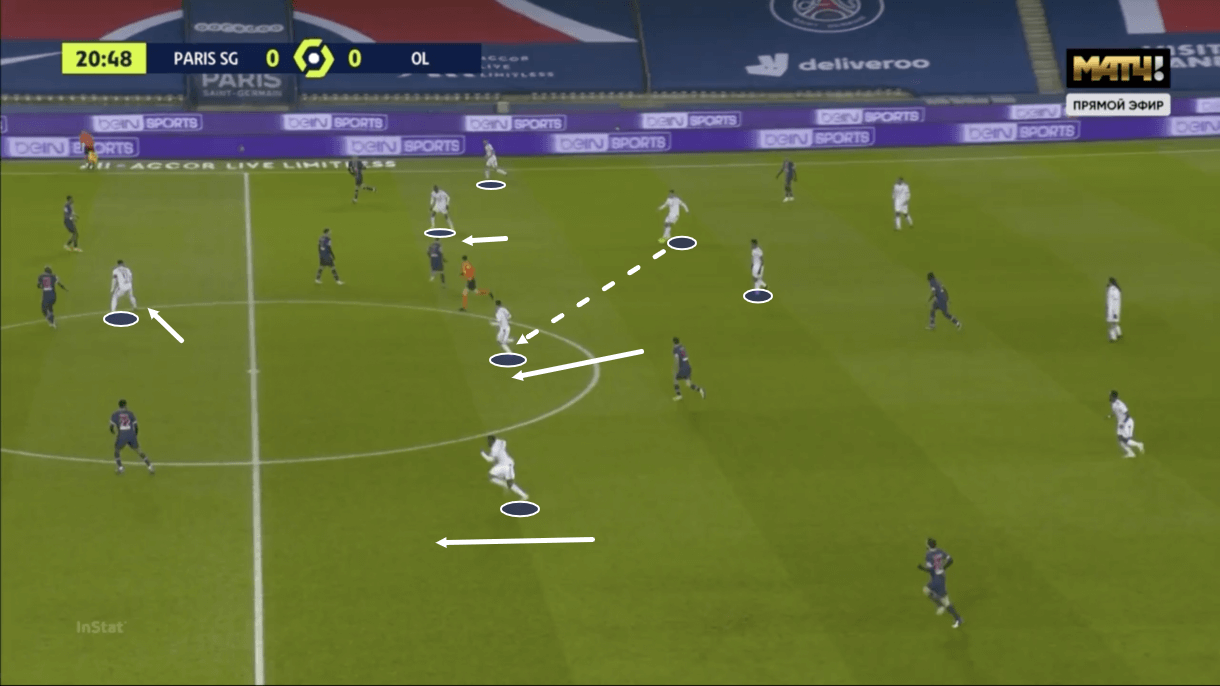
Lastly, Lyon thrived on the counter in this game. One reason for that was the quality of dribbler they had in their side, and how well they did at getting them on the ball with space to run into. Lyon managed to get Depay and Aouar into space far better than PSG managed to get Neymar or Di María into threatening areas. We can see one example of Paquetá finding Aouar in space running through the centre of the pitch to kickstart a counter-attack in the image above.
As this passage of play moves on, Aouar carries the ball into the opposition’s half, evading a couple of tackles in the process, highlighting how effective he could be, as an elite dribbler, when found with space to run into.
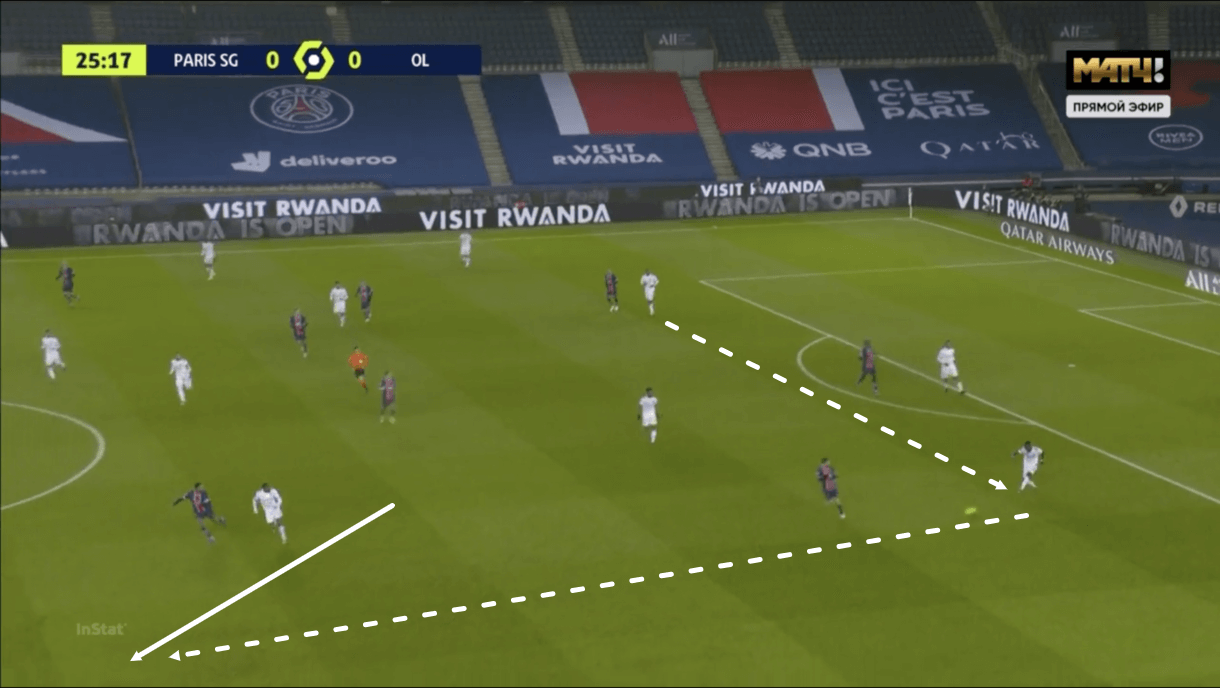
The progressive passing ability of Lyon’s backline was another key aspect to their counter-attacking success, as was the speed and intelligent movement of their wide men. We can see both of these aspects to their attacking game on show in the image above. They demonstrated these qualities throughout the game to great success.
Conclusion
To conclude this tactical analysis piece, it’s clear that Lyon thrived in transition in Sunday’s game. Their effective pressing, combined with their devastating counter-attacking qualities were enough to help them to open up PSG and do all they needed to do to get three points in this one.
Meanwhile, though PSG did come up with a few ways to effectively beat Lyon’s press, they struggled to create clear chances once they reached the final third and this was the main reason why they left Le Parc des Princes without a goal on Sunday.





Comments